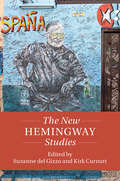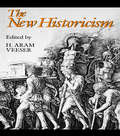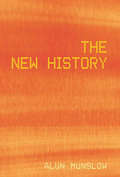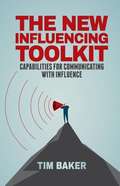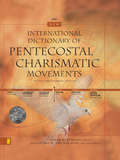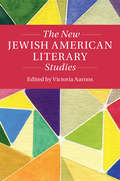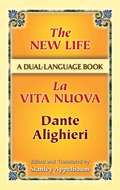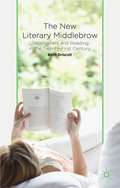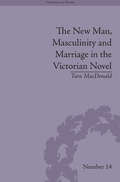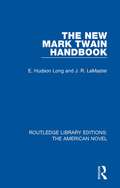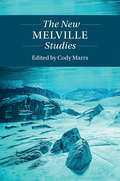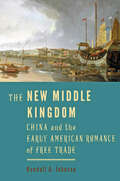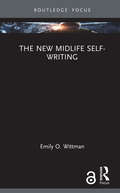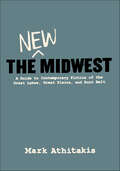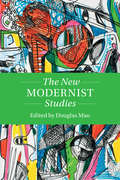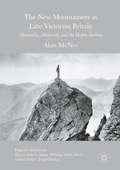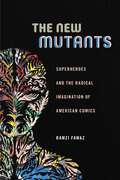- Table View
- List View
The New Fiction: (A Protest against Sex-Mania) And Other Papers (Routledge Revivals)
by J.A. SpenderThis collection of essays attempts to analyse common assumptions about art, literature and criticism at the time of publication in 1895. Taking the position of ‘a Philistine’ , Spender argues against the ‘new’ art and fiction and encourages the average member of the public to state their opinion and give validation that the average view is just as worthy as the ‘new’ criticism which tended toward superiority. This title will be of interest to students of Literature, Art and Art History.
The New Hemingway Studies (Twenty-First-Century Critical Revisions)
by Kirk CurnuttThe subject of endless biographies, fictional depictions, and critical debate, Ernest Hemingway continues to command attention in popular culture and in literary studies. He remains both a definitive stylist of twentieth-century literature and a case study in what happens to an artist consumed by the spectacle of celebrity. The New Hemingway Studies examines how two decades of new-millennium scholarship confirm his continued relevance to an era that, on the surface, appears so distinct from his—one defined by digital realms, ecological anxiety, and globalization. It explores the various sources (print, archival, digital, and other) through which critics access Hemingway. Highlighting the latest critical trends, the contributors to this volume demonstrate how Hemingway's remarkably durable stories, novels, and essays have served as a lens for understanding preeminent concerns in our own time, including paranoia, trauma, iconicity, and racial, sexual, and national identities.
The New Historicism
by H. Aram VeeserFollowing Clifford Geertz and other cultural anthropologists, the New Historicist critics have evolved a method for describing culture in action. Their "thick descriptions" seize upon an event or anecdote--colonist John Rolfe's conversation with Pocohontas's father, a note found among Nietzsche's papers to the effect that "I have lost my umbrella"--and re-read it to reveal through the analysis of tiny particulars the motive forces controlling a whole society. Contributors: Stephen J. Greenblatt, Louis A. Montrose, Catherine Gallagher, Elizabeth Fox-Genovese, Gerald Graff, Jean Franco, Gayatri Chakravorty Spivak, Frank Lentricchia, Vincent Pecora, Jane Marcus, Jon Klancher, Jonathan Arac, Hayden White, Stanley Fish, Judith Newton, Joel Fineman, John Schaffer, Richard Terdiman, Donald Pease, Brooks Thomas.
The New Historicism and Other Old-Fashioned Topics
by Brook ThomasBrook Thomas explores the new historicism and the challenges posed to it by a postmodern world that questions the very possibility of newness. He considers new historicism's engagement with poststructuralism and locates the former within a tradition of pragmatic historiography in the United States.
The New History
by Alun MunslowThe notion of 'history' has always been one strenuously debated by both academics and the wider population. This deeply provocative re-thinking of our engagement with the past by one of the world's leading post-modern historians takes that debate one step further. Alun Munslow re-assesses history in the light of post-modernism and other intellectual challenges which have questioned the primacy of the modernist epistemology of empiricism. In an original and stimulating vision of history that will intrigue all those seriously interested in the subject, Munslow argues that history is not only about the sources, but a literary construction. Munslow concludes that history, as a cultural narrative about the past can never tell us what the past really means. This far reaching conclusion is based on the radical idea that the content of history is defined as much by the nature of the language used to represent and interpret that content as it is by research into the sources. This suggests that history does not produce the most likely meaning of the past but rather can only generate alternative meanings. The lead volume in a major new series on historical thinking and practice, this is an accessible yet absorbing study that breaks new ground in discussing the stage history is at now, and perhaps most engagingly, the direction it will take in the future.
The New ICT Ecosystem
by Martin FransmanThe ICT sector is crucial as a driver of economic and social growth. Not only is it an important industry in its own right, but it also provides the communication and infrastructure without which modern economies could not function. How does this sector work? Why is it stronger in some countries than in others? What should companies, governments and regulators be doing to enhance its contribution? In The New ICT Ecosystem, Martin Fransman answers these and other questions by developing the idea of the ICT sector as an evolving ecosystem. He shows that some components of the ICT ecosystem, particularly the innovation process, work better in some countries and regions (e. g. the USA) than in others (e. g. Europe and the developing world). This enables policy makers and regulators to understand why some parts of the ICT ecosystem are underperforming and what can be done to enhance their performance. The previous edition of The New ICT Ecosystem won the 2008-09 Joseph Schumpeter Prize.
The New Influencing Toolkit
by Tim BakerWithout influence, managers are ineffective. In today's workplace, managers need to influence up, down and increasingly, sideways as organizations become less hierarchical. This book is expertly designed to diagnose and develop managerial influence, focusing on four key strategies: investigating, calculating, motivating and collaborating.
The New International Dictionary of Pentecostal and Charismatic Movements: Revised and Expanded Edition
by Stanley M. Burgess Eduard M. van der MaasThe Definitive History of the Spirit-Filled Church Encyclopedic coverage of: Activities of the Spirit over 2,000 years of church history in 60 countries and regions Outpourings at Topeka, Mukti Mission (India), Azusa Street, Duquesne University, and many other 20th-century locations Current movements among today’s 500 million-plus Pentecostal and charismatic Christians worldwide The New International Dictionary of Pentecostal and Charismatic Movements sets modern, Spirit-filled Christianity in a context that spans two millennia and the entire Christian world. Like no other resource, this volume reveals in detail the full, sweeping legacy of Spirit-empowered movements that have touched hearts and lives both in modern America and across the centuries and continents: in medieval Europe, Finland in the 1700s, South India in the 1800s, Azusa Street at the turn of the 20th century--and much more, including ongoing moves of the Holy Spirit throughout the world today. One thousand entries provide the most extensive information available on Pentecostal, charismatic, and neocharismatic movements. The diverse topics covered include, as a small sample, glossolalia, black and Hispanic Pentecostalism, prophecy, the role of women, faith healing, music, sociology, missions, church growth, and different historic and contemporary revivals. With its unique international and historical perspective, this completely revised and expanded second edition of the acclaimed Dictionary of Pentecostal and Charismatic Movements offers features that no other reference of its kind approaches. Its extraordinary scope and detailed, up-to-date coverage make this the definitive resource on Pentecostal and charismatic denominations and movements both in North America and worldwide. Includes: Exhaustive coverage of Pentecostal and charismatic movements in 60 countries and regions--individual histories, cultural and theological aspects, and key figures and institutions. Statistical section with a wealth of current information on the growth of classical Pentecostalism as well as charismatic and neocharismatic movements. 1,000 articles. Over 500 photos and illustrations, maps, and timeline. Cross references, bibliographies, and indexes to people, places, and topics.
The New Jewish American Literary Studies (Twenty-First-Century Critical Revisions)
by Victoria AaronsThe opening decades of the twenty-first century are distinguished by a newly framed and regenerated outlook of Jewish American literary studies. This volume introduces readers to the new perspectives, new approaches, and widening of interpretive possibilities in Jewish American literature accompanied by the changes of the new millennium. Now that we are over a decade into a new century, the field of Jewish American literary studies has begun to reshape itself in response to a 'new diaspora', a newly defined sense not only of Jewish American literature, but of America, an expansion of new genres, new voices, and new platforms of expression. This book re-evaluates questions of race, feminism, gender, sexuality, orthodoxy, assimilation, identity politics, and historical alienation that shape Jewish American literary studies. Several chapters show the influence of other cultures on the field such as Iranian-American-Jewish writing, Israeli-American, and Latin American literary expression, as well as the impact of Russian emigres.
The New Journalism, the New Imperialism and the Fiction of Empire, 1870-1900 (Palgrave Studies in the History of the Media)
by Andrew GriffithsAggressive policy, enthusiastic news coverage and sensational novelistic style combined to create a distinctive image of Britain's Empire in late-Victorian print media. The New Journalism, the New Imperialism and the Fiction of Empire, 1870-1900 traces this phenomenon through the work of editors, special correspondents and authors.
The New Joyce Studies (Twenty-First-Century Critical Revisions)
by Flynn CatherineThe New Joyce Studies indicates the variety and energy of research on James Joyce since the year 2000. Essays examine Joyce's works and their reception in the light of a larger set of concerns: a diverse international terrain of scholarly modes and methodologies, an imperilled environment, and crises of racial justice, to name just a few. This is a Joyce studies that dissolves early visions of Joyce as a sui generis genius by reconstructing his indebtedness to specific literary communities. It models ways of integrating masses of compositional and publication details with literary and historical events. It develops hybrid critical approaches from posthuman, medical, and queer methodologies. It analyzes the nature and consequences of its extension from Ireland to mainland Europe, and to Africa and Latin America. Examining issues of copyright law, translation, and the history of literary institutions, this volume seeks to use Joyce's canonical centrality to inform modernist studies more broadly.
The New Kid
by Temple MathewsWill Hunter is used to being the New Kid; Harrisburg High School is his fifth new school in less than three years. By now, he knows not to be fooled by the bright pep rallies, the wholesome jocks, the innocent cheerleaders. He knows the evil lurking underneath. It's the same evil that took his dad eight years ago: the same evil he battles every day. Natalie Holand's life fell apart the night her sister Emily disappeared. No one believes her when she tells them what she saw: yellow and green eyes, glowing beneath the surface of the water in which Emily supposedly drowned. And Emily isn't the only person to go missing in Harrisburg lately. The town is changing, not for the better, and Natalie doesn't know why. What she does know is that, whatever's happening, it's bad, and the New Kid is right in the middle of it. Because Will's got a secret even bigger than Harrisburg's . . . and there's more to it than even he knows.
The New Life/La Vita Nuova: A Dual-Language Book
by Dante Alighieri Stanley AppelbaumAn exquisite medley of lyrical verse and poetic prose, La Vita Nuova (The New Life) ranks among the supreme revelations in the literature of love. Its allegorical view of the soul's crisis and growth combines a narrative with meditations, dreams, songs, and prayers.In this masterpiece of his youth, Dante assembles a selection of his love poems within a prose framework that situates them chronologically and autobiographically. The result is a history of his love for Beatrice, the muse he encountered in childhood who continued to influence him long after her marriage and early death. Upon completing this work in 1294, the future author of The Divine Comedy pledged to write of Beatrice "what has never before been written of any woman."Instructors and students of Italian, as well as anyone interested in the masterworks of world literature, will appreciate this dual-language edition. It features a new English translation, in addition to an informative introduction and helpful notes.
The New Literary Middlebrow
by Beth DriscollThe middlebrow is a dominant cultural force in the twenty-first century. This book defines the new literary middlebrow through eight key features: middle class, feminized, reverential, commercial, emotional, recreational, earnest and mediated. Case studies include Oprah's Book Club, the Man Booker Prize and the Harry Potter phenomenon.
The New Man, Masculinity and Marriage in the Victorian Novel (Gender and Genre #14)
by Tara MacDonaldBy tracing the rise of the New Man alongside novelistic changes in the representations of marriage, MacDonald shows how this figure encouraged Victorian writers to reassess masculine behaviour and to re-imagine the marriage plot in light of wider social changes. She finds examples in novels by Dickens, Anne Brontë, George Eliot and George Gissing.
The New Mark Twain Handbook (Routledge Library Editions: The American Novel #9)
by E. Hudson Long J. R. LeMasterThis authors of this useful handbook, originally published in 1985, not only summarise Mark Twain scholarship, but also evaluate, in much detail, the various contributions. Each chapter includes a thorough annotated bibliography. This title also includes a comprehensive chronological table of the significant events in Mark Twain’s Life, including the publication dates of his works. This title will be of interest to students of American Literature.
The New Melville Studies, Part 1: Twenty-first Century Critical Revisions (Twenty-First-Century Critical Revisions)
by Cody MarrsWhat does Melville studies look like after a phase of intense critical activity? This book addresses that question by analyzing Melville as a writer who was keenly interested in the pleasures, limits, and possibilities of various reading practices. It collects and assesses all of the major new trends in Melville studies. Essays, written by some of the leading scholars in the field, test out emerging critical methods. They explore Melville's centrality to American literary studies and consider the full range of Melville's career, connecting his poetry to his prose. This collection re-imagines Melville as a theorist as well as a writer, approaching his works as philosophical forms in their own right. It shows how scholars are changing Melville studies not only by re-orienting the texts upon which those studies are based, but also by incorporating new approaches that unsettle prior assumptions and interpretive claims.
The New Middle Ages
by Jerold C. FrakesBroadens the perspective of recent work on the discourse of the Muslim Other in medieval Christendom by investigating pertinent texts, art, and artefacts, situating these local discourses of the Muslim Other in the larger cultural context of proto-Eurocentric discourse.
The New Middle Kingdom: China and the Early American Romance of Free Trade
by Kendall A. JohnsonLooking at the Far East and American ambition in China through the lens of literature.In the imaginations of early Americans, the Middle Kingdom was the wealthiest empire in the world. Its geographical distance did not deter commercial aspirations—rather, it inspired them. Starting in the late eighteenth century, merchants from New York, Philadelphia, Boston, Salem, Newport, and elsewhere cast speculative lines to China. The resulting fortunes shaped the cultural foundation of the early republic and funded westward frontier expansion. In The New Middle Kingdom, Kendall A. Johnson argues that—for the merchant princes who speculated in the global Far East, as well as the missionaries and diplomats who followed them—Manifest Destiny spurred more than the coalescence of the fractious regions into the continental Far West. It also promised a golden gateway to the Pacific Ocean through which the nation would realize its historical destiny as the world’s new Middle Kingdom of commerce. Examining the influential accounts of westerners at the center of early US cultural development abroad, Johnson conceives a romance of free trade with China as a quest narrative of national accomplishment in a global marketplace.Drawing from a richly descriptive cross-cultural archive, the book presents key moments in early relations among the twenty-first century’s superpowers through memoirs, biographies, epistolary journals, magazines, book reviews, fiction and poetry by Melville, Twain, Whitman, and others, travel narratives, and treaties, as well as maps and engraved illustrations. Paying close attention to figurative language, generic forms, and the social dynamics of print cultural production and circulation, Johnson shows how authors, editors, and printers appealed to multiple overlapping audiences in China, in the United States, and throughout the world. Spanning a full century, from the post–Revolutionary War era to the Gilded Age, The New Middle Kingdom is a vivid look at the Far East through Western eyes, one that highlights the importance of China in antebellum US culture.
The New Midlife Self-Writing (Routledge Focus on Literature)
by Emily O. WittmanIn The New Midlife Self-Writing, Wittman treats recent self-writing by Rachel Cusk, Roxane Gay, Sarah Manguso, and Maggie Nelson, carefully situating these vital midlife works within the history of self-writing. She argues that they renew and redirect the autobiographical trajectories characteristic of earlier self-writing by switching their orientation to face the future and by celebrating midlife as a growing season, a time of Bildung. In each chapter, writer-by-writer, she demonstrates how the midlife self-writers in question trace confident and future-oriented paths through the past, rejecting triumphalism and complicating both identity and individualism, just as they refine and redefine genres. Exploring these midlife self-writers as chroniclers of Generation X’s midlife in particular, Wittman coins the term "digital absence" to map their unique relationship to new forms of knowledge and knowledge gathering in an Information Age that they are both of and set apart from. She theorizes that their works share a "pedagogical style," a style characterized by clarity, exposition, and classical rhetoric, as well as a concern with the classroom, offering a warrant for reading them in pedagogical terms in concert with traditional scholarly approaches. Furthermore, Wittman presents readers with a look ahead at the future of midlife self-writing as well as self-writing overall, concluding that we might be looking at the scholarship of the future.
The New Midwest: A Guide to Contemporary Fiction of Great Lakes, Great Plains, and Rust Belt
by Mark Athitakis&“Dives deep into Midwestern literature, unpacking the mythology of the region and how today&’s writers are complicating our simple idea of the Heartland.&” —Huffington Post In the public imagination, Midwestern literature has not evolved far beyond heartland laborers and hardscrabble immigrants of a century past. But as the region has changed, so, in many ways, has its fiction. In this book, the author explores how shifts in work, class, place, race, and culture has been reflected or ignored by novelists and short story writers. From Marilynne Robinson to Leon Forrest, Toni Morrison to Aleksandar Hemon, Bonnie Jo Campbell to Stewart O&’Nan this book is a call to rethink the way we conceive Midwestern fiction, and one that is sure to prompt some new must-have additions to every reading list. &“Using the lens of novels and short stories published over the past 30 or so years, Athitakis seeks to illuminate the ways we still lean on literary mythology of the Midwest when it comes to defining the region.&” —Chicago Tribune &“[The New Midwest] rightly praises the Midwestern novels of Marilynne Robinson, Jeffrey Eugenides, Toni Morrison and Jonathan Franzen, but also points out works of comparable merit that warrant rediscovery.&” —The Washington Post &“The New Midwest is a crisp, engaging tip sheet and guide for further reading.&” —Milwaukee Journal-Sentinel &“A journey through the Midwest and through some key works by writers [Athitakis] thinks are most effectively using the region in their fiction.&” —Kirkus Reviews
The New Milton Criticism
by Peter C. Herman Elizabeth SauerThe New Milton Criticism seeks to emphasize ambivalence and discontinuity in Milton's work and interrogate the assumptions and certainties in previous Milton scholarship. Contributors to the volume move Milton's open-ended poetics to the centre of Milton studies by showing how analysing irresolvable questions – religious, philosophical and literary critical – transforms interpretation and enriches appreciation of his work. The New Milton Criticism encourages scholars to embrace uncertainties in his writings rather than attempt to explain them away. Twelve critics from a range of countries, approaches and methodologies explore these questions in these new readings of Paradise Lost and other works. Sure to become a focus of debate and controversy in the field, this volume is a truly original contribution to early modern studies.
The New Modernist Studies (Twenty-First-Century Critical Revisions)
by Douglas MaoThis is the first book specifically devoted to the new modernist studies. Bringing together a range of perspectives on the past, present, and future of this vibrant, complicated scholarly enterprise, the collection reconsiders its achievements and challenges as both a mode of inquiry and an institutional formation. In its first section, the volume offers a fresh history of the new modernist studies' origins amid the intellectual configurations of the end of the twentieth century and changing views of the value, influence, and scope of modernism. In the second section a dozen leading scholars examine recent trends in modernist scholarship to suggest possible new paths of research, showing how the field continues to engage with other areas of study and how it makes a case for the ongoing meaning of modernist literature and art in the contemporary world.
The New Mountaineer in Late Victorian Britain
by Alan McneeThis book is about the rise of a new ethos in British mountaineering during the late nineteenth century. It traces how British attitudes to mountains were transformed by developments both within the new sport of mountaineering and in the wider fin-de-siècle culture. The emergence of the new genre of mountaineering literature, which helped to create a self-conscious community of climbers with broadly shared values, coincided with a range of cultural and scientific trends that also influenced the direction of mountaineering. The author discusses the growing preoccupation with the physical basis of aesthetic sensations, and with physicality and materiality in general; the new interest in the physiology of effort and fatigue; and the characteristically Victorian drive to enumerate, codify, and classify. Examining a wide range of texts, from memoirs and climbing club journals to hotel visitors' books, he argues that the figure known as the 'New Mountaineer' was seen to embody a distinctly modern approach to mountain climbing and mountain aesthetics.
The New Mutants: Superheroes and the Radical Imagination of American Comics (Postmillennial Pop #1)
by Ramzi Fawaz2017 The Association for the Studies of the Present Book PrizeFinalist Mention, 2017 Lora Romero First Book Award Presented by the American Studies AssociationWinner of the 2012 CLAGS Fellowship Award for Best First Book Project in LGBT StudiesHow fantasy meets reality as popular culture evolves and ignites postwar gender, sexual, and race revolutions.In 1964, noted literary critic Leslie Fiedler described American youth as “new mutants,” social rebels severing their attachments to American culture to remake themselves in their own image. 1960s comic book creators, anticipating Fiedler, began to morph American superheroes from icons of nationalism and white masculinity into actual mutant outcasts, defined by their genetic difference from ordinary humanity. These powerful misfits and “freaks” soon came to embody the social and political aspirations of America’s most marginalized groups, including women, racial and sexual minorities, and the working classes.In The New Mutants, Ramzi Fawaz draws upon queer theory to tell the story of these monstrous fantasy figures and how they grapple with radical politics from Civil Rights and The New Left to Women’s and Gay Liberation Movements. Through a series of comic book case studies—including The Justice League of America, The Fantastic Four, The X-Men, and The New Mutants—alongside late 20th century fan writing, cultural criticism, and political documents, Fawaz reveals how the American superhero modeled new forms of social belonging that counterculture youth would embrace in the 1960s and after. The New Mutants provides the first full-length study to consider the relationship between comic book fantasy and radical politics in the modern United States.

